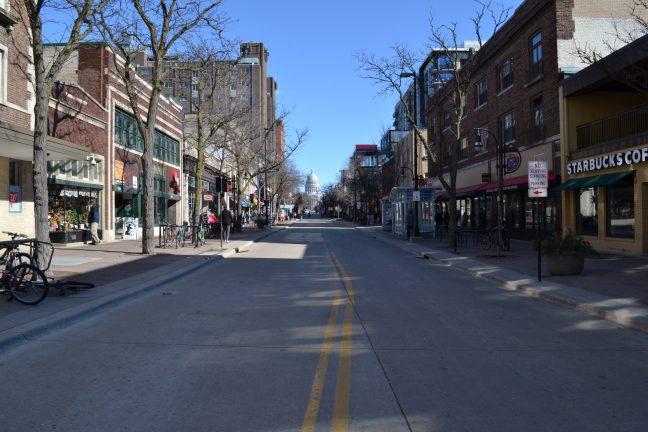William Grant Turnbull was recently approached about his latest public art piece, “StateScreen,” by a man who recognized him. The man told Turnbull that when someone threw their burger wrapper on the sculpture, he cleaned it up.
This is the exact kind of civic engagement and appreciation “StateScreen” and many other public art pieces in Madison are hoping to promote.
Located next to the Wisconsin Veterans Museum, “StateScreen” is an aluminum cityscape installed on top of a low wall that features 11 intricately crafted Madison landmarks.
This piece was commissioned by the city as a part of Madison’s new “placemaking” efforts. Rebecca Cnare, an urban design planner for the city, said placemaking is all about having positive things for people to do in a space.
“An absence of things to do can bring about places that people avoid, which can attract criminal and other non-positive activity,” Cnare said.
This idea of placemaking is a part of the cities new “two-pronged” approach to improving conditions at the top of State Street. Cnare explained that the first prong focuses on promoting positive activity on State Street and the second prong is about increasing the social services that are available to Madison’s homeless population.
Cnare added that one important aspect of placemaking is the “Power of 10” – the idea that to make a space successful there must be at least 10 things to do there. Now admiring “StateScreen” can be added to State Street’s list of activities.
Karin Wolf, the city’s arts administrator, pointed out that while public art is not the only solution to Madison’s social and economic issues, it is more effective than people think.
Wolf referenced an email she once got from a concerned citizen who criticized her for spending money on public art when “there are people sleeping on the street.” Wolf said public art can actually be very cost effective and has a large impact.
“People respond very positively to public art … across the board, all people seem to enjoy beauty,” Wolf said. “We try to put beauty in our built environment … I think it does create a positive atmosphere.”
Turnbull said the sculpture was actually one of the cheapest solutions to the crime that had been occurring near the Veterans Museum. The bench “StateScreen” was installed on had attracted criminal behavior for years, but removing the bench would have cost more money than the installation, Turnbull said.
While Madison’s public art budget is always being threatened, it will likely never be cut because of how valuable public art is to the city, Turnbull said.
“It raises property value, so it actually pays for itself with increased tax values … public art is always a good investment for any municipality really,” Turnbull said.
Turnbull also described his own transition from private to public art, explaining that he got tired of creating things that very few people would see. He decided that rather than make “baubles for the insanely wealthy” he wanted to make art that everyone could enjoy.
Turnbull stressed that art should be available to everyone, including Madison’s homeless population. Explaining that even though Madison has many free museums, people who are homeless don’t always feel welcome in these spaces, whereas “StateScreen” is located at a spot frequented by people who are homeless.
“Nobody is really seeing to their needs for beauty,” Turnbull said. “The stuff I build, you have just as much of right to it as anybody on the street.”
“StateScreen” is just one of many new art installations throughout Madison. Cnare said both the utility boxes that were decorated with wraps from local artists and the “Flamingo Wings” and “Hodag Claws & Horns” that were painted on the outside wall of the Wisconsin Historical Museum were done with placemaking in mind.
This support of public art will continue, Wolf said. There are plans to fund temporary art projects throughout downtown Madison this summer.
This continued support of public art is important because it shapes the way citizens view their environment, Wolf said.
“I do believe in the power of art … even if it’s just a little respite in your day,” Wolf said.


